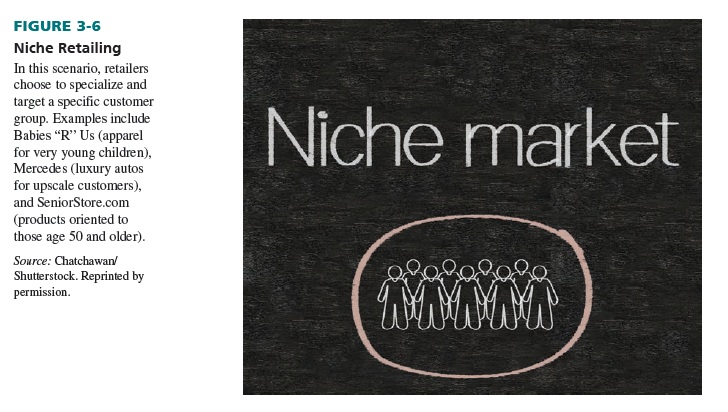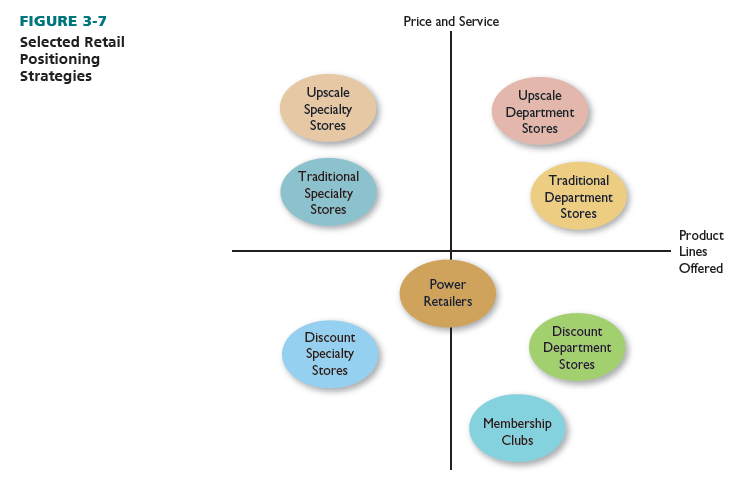After situation analysis, a retailer sets objectives, the long-run and short-run performance targets it hopes to attain. This helps in strategy and translates the organizational mission into action. A firm can pursue goals related to one or more of these areas: sales, profit, satisfaction of publics, and image. Some retailers strive to achieve all these goals; others attend to a few and want to
achieve them really well. Think about the array of goals for the Kroger Company: competitive pricing while maintaining profitability, long-term sales growth, and reducing operations costs.9
1. Sales
Sales objectives are related to the volume of goods and services a retailer sells. Growth, stability, and market share are the sales goals most often sought.
Some retailers set sales growth as a top priority. They want to expand their business; therefore, they may place less emphasis on short-run profits. The assumption is that current investments will yield future sales and profits. A firm that does well often becomes interested in opening new units, expanding channel coverage and enlarging revenues. However, management skills and the personal touch are sometimes lost with overly fast expansion.
Stability is the goal of retailers that emphasize maintaining their sales volume, market share, price lines, and so on. Small retailers often seek stable sales that enable the owners to make a satisfactory living every year without downswings or upsurges. And certain firms develop a loyal customer following and are intent not on expanding but on continuing the approach that attracted the original consumers.
For some firms, market share—the percentage of total retail-category sales contributed by a given company—is another goal. It is often an objective only for large retailers or retail chains. The small retailer is more concerned with competition across the street than with total sales in a metropolitan area.
Sales objectives may be expressed in dollars and units. To reach dollar goals, a retailer can engage in a discount strategy (low prices and high unit sales), a moderate strategy (medium prices and medium unit sales), or a prestige strategy (high prices and low unit sales). In the long run, having unit sales as a performance target is vital. Dollar sales by year may be difficult to compare due to changing retail prices and inflation; unit sales are easier to compare. A firm with sales of $350,000 3 years ago and $500,000 today might assume it is doing well, until unit sales are computed: 10,000 then and 8,000 now.
2. Profit
With profitability objectives, retailers seek at least a minimum profit level during a designated period, usually a year. Profit may be expressed in dollars or as a percentage of sales. For a firm with yearly sales of $5 million and total costs of $4.2 million, pre-tax dollar profit is $800,000 and profits as a percentage of sales are 16 percent. If the profit goal is equal to or less than $800,000, or 16 percent, the retailer is satisfied. If the goal is higher, the firm has not attained the minimum desired profit and is dissatisfied.
Firms with large capital expenditures in land, buildings, and equipment often set return on investment (ROI) as a goal. Return on investment is the relationship between profits and the investment in capital items. A satisfactory rate of return is pre-defined and compared with the actual return at the end of the year or other period. For a retailer with annual sales of $5 million and expenditures (including payments for capital items) of $4 million, the yearly profit is $1 million. If the total capital investment is $10 million, ROI is $1 million/$10 million, or 10 percent per year. The goal must be 10 percent or less for the firm to be satisfied.
Operating efficiency may be expressed as 1- (operating expenses/company sales). The higher the result, the more efficient the firm. A retailer with sales of $2 million and operating costs of $1 million has a 50 percent efficiency rating ([1- ($1 million/$2 million)]). Of every sales dollar, 50 cents goes for nonoperating costs and profits, and 50 cents for operating expenses. The retailer might set a goal to increase efficiency to 60 percent. On sales of $2 million, operating costs would have to drop to $800,000 ([1- ($800,000/$2 million)]). Sixty cents of every sales dollar would then go for nonoperating costs and profits, and 40 cents for operations, which would lead to better profits. If a firm cuts expenses too much, customer service may decline; this in turn might lead to a decline in sales and profit.
3. Satisfaction of Publics
Retailers typically strive to satisfy their publics; that is, their stockholders, customers, suppliers, employees, and government. Stockholder satisfaction is a goal for any publicly owned retailer. Some firms set policies leading to small annual increases in sales and profits (because these goals can be sustained over the long run and indicate good management) rather than ones based on innovative ideas that may lead to peaks and valleys in sales and profits (indicating risky decisions). Stable earnings lead to stable dividends.
Customer satisfaction with the total retail experience is a well-entrenched goal at most firms now. Policies of caveat emptor (“Let the buyer beware”) or “the absence of complaints indicates that customers are satisfied” will not work in today’s competitive marketplace. Retailers must listen to criticism and adapt. If shoppers are pleased, other goals are more easily reached. Yet, for many retailers, other objectives rate higher than customer satisfaction in their list of priorities.
Good supplier relations is also a key goal. Retailers must understand and work with their suppliers to secure favorable purchase terms, new products, good return policies, prompt shipments, and cooperation. Relationships are very important for small retailers due to the many services that suppliers offer them.
Cordial labor relations is another goal that is often critical to retailers’ performance. Good employee morale means less absenteeism, better treatment of customers, and lower staffing turnover. Relations can be improved by effective selection, training, and motivation.
Because all levels of government impose rules affecting retailing practices, another goal should be to understand and adapt to government rules. In some cases, firms can influence rules by acting as members of large groups, such as trade associations or chambers of commerce.
4. Image (Positioning)
An image represents how a given retailer is perceived by consumers and others. A firm may be seen as innovative or conservative, specialized or broad-based, discount-oriented or upscale. The key to a successful image is that consumers view the retailer in the manner the firm intends.
Through positioning, a retailer devises its strategy in a way that projects an image relative to its retail category and its competitors and that elicits a positive consumer response. A firm selling women’s apparel, for example, could generally position itself as an upscale or mid-priced specialty retailer, a traditional department store, a discount department store, or a discount specialty retailer, and it could specifically position itself with regard to other retailers carrying women’s apparel.
Two opposite positioning philosophies have gained popularity in recent years: mass merchandising and niche retailing. Mass merchandising is a positioning approach whereby retailers offer a discount or value-oriented image, a wide and/or deep merchandise selection, and large store facilities. Walmart has a wide, deep merchandise mix, whereas Dick’s Sporting Goods has a narrower, deeper assortment. These firms appeal to a broad customer market, attract a lot of customer traffic, and generate high stock turnover. Because mass merchants have relatively low operating costs, achieve economies in operations, and appeal to value-conscious shoppers, their continuing popularity is forecast.
In niche retailing, retailers identify specific customer segments and deploy unique strategies to address the desires of those segments rather than the mass market. Niching creates a high level of loyalty and shields retailers from more conventional competitors. Babies “R” Us appeals to parents with very young children, whereas Catherines Stores has fashions for plus-size women. A niche retailing approach will have a strong future because it lets retailers stress factors other than price and have a better focus. See Figure 3-6.
Because both mass merchandising and niche retailing are now popular, some observers call this the era of bifurcated retailing. They believe this may mean the decline of middle-of-the- market retailing. Firms that are neither competitively priced nor particularly individualistic may have more difficulty competing.
Let’s further examine the concept of positioning through these two examples:
- The bebe apparel chain designs, develops, and produces contemporary women’s apparel and accessories targeted to 18- to 35-year-old sophisticated, hip, body-conscious women who seek current fashion trends to suit their lifestyle needs.10
- The underpinning of Trader Joe’s food stores’ strategy is to provide “value.” The firm offers everyday low prices on all the items it sells without the need for “loyalty” cards, clubs, or gimmicks. Trader Joe’s focuses on what matters: “great food + great prices = value.”11

Figure 3-7 shows a retail positioning map based on two shopping criteria: (1) price and service and (2) product lines offered. Our assumption: There is a link between price and service (high price equals excellent service). Upscale department stores (Neiman Marcus) offer outstanding customer service and carry prestigious designer apparel. Traditional department stores (Sears) focus more on appliances, tools, auto repair, and private-label apparel. Discount department stores (Walmart) carry a broad variety of product lines and rely on self-service. Membership clubs (Costco) have a limited selection in a number of product categories. They have very low prices and warehouse type surroundings. Upscale specialty stores (Tiffany) offer outstanding customer service and focus on one general product category. Traditional specialty stores (Gap) have a trained sales staff to help customers and focus on apparel needs for the entire family. Discount specialty stores (Old Navy) rely more on self-service and focus on one general product category. Power retailers (Ikea) offer moderate service, low prices, and a huge assortment within one general product category.

5. Selection of Objectives
A firm that sets clear goals and devises a strategy to attain them improves its chances of success. An example of a retailer with clear goals and a proper strategy to attain them is Papa John’s, the 4,900-outlet pizza chain that has stores in all 50 U.S. states and 37 countries. As reported at its Web site (www.papajohns.com), Papa John’s focuses on customers. It seeks to generate strong brand loyalty via “(a) authentic, superior-quality products, (b) legendary customer service, and (c) exceptional community service.”
Source: Barry Berman, Joel R Evans, Patrali Chatterjee (2017), Retail Management: A Strategic Approach, Pearson; 13th edition.

obviously like your website however you need to test the spelling on several of your posts. A number of them are rife with spelling issues and I to find it very troublesome to inform the reality on the other hand I’ll certainly come again again.
Hi, Neat post. There is an issue along with your web site in internet explorer, may test thisK IE nonetheless is the market chief and a large part of folks will pass over your excellent writing due to this problem.